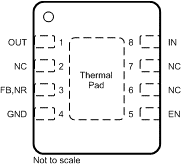SFFS949 July 2024 TPS735-Q1
4 Pin Failure Mode Analysis (Pin FMA)
This section provides a failure mode analysis (FMA) for the pins of the TPS735-Q1. The failure modes covered in this document include the typical pin-by-pin failure scenarios:
- Pin short-circuited to ground (see Table 4-2)
- Pin open-circuited (see Table 4-3)
- Pin short-circuited to an adjacent pin (see Table 4-4)
- Pin short-circuited to VIN (see Table 4-5)
Table 4-2 through Table 4-5 also indicate how these pin conditions can affect the device as per the failure effects classification in Table 4-1.
| Class | Failure Effects |
|---|---|
| A | Potential device damage that affects functionality. |
| B | No device damage, but loss of functionality. |
| C | No device damage, but performance degradation. |
| D | No device damage, no impact to functionality or performance. |
Figure 4-1 shows the TPS735-Q1 pin diagram. For a detailed description of the device pins, see the Pin Configuration and Functions section in the TPS735-Q1 data sheet.
 Figure 4-1 Pin Diagram
Figure 4-1 Pin DiagramFollowing are the assumptions of use and the device configuration assumed for the pin FMA in this section:
- Device contains DRB pin configuration. Device operates at free-air temperatures between -40°C and 125°C. Device operates at an input voltage less than 6.5V and output current less than 500mA.
- Device operates according to all recommended operating conditions and does not exceed the absolute maximum ratings.
| Pin Name | Pin No. | Description of Potential Failure Effects | Failure Effect Class |
|---|---|---|---|
| OUT | 1 | Regulation is not possible, the device operates at current limit. The device can cycle in and out of thermal shutdown. | B |
| NC | 2, 6, 7 | No effect. Normal operation. | D |
| FB, NR | 3 | (Fixed) Proper regulation without the ability to bypass noise generation. | B |
| (Adjustable) The device is disabled, resulting in no output voltage. | |||
| GND | 4 | No effect. Normal operation. | D |
| EN | 5 | The device is disabled, resulting in no output voltage. | B |
| IN | 8 | Power is not supplied to the device. System performance depends on upstream current limiting. | B |
| Pin Name | Pin No. | Description of Potential Failure Effects | Failure Effect Class |
|---|---|---|---|
| OUT | 1 | The device output is disconnected from the load. | B |
| NC | 2, 6, 7 | No effect. Normal operation. | D |
| FB, NR | 3 | (Fixed) Proper regulation without the ability to bypass noise generation. | B |
| (Adjustable) The device state is unknown. If the device is on, the output voltage is indeterminate. | |||
| GND | 4 | There is no current loop for the supply voltage. The device is not operational and does not regulate. | B |
| EN | 5 | The device state is unknown. If the device is on, the output voltage is indeterminate. | B |
| IN | 8 | Power is not supplied to the device. | B |
| Pin Name | Pin No. | Shorted to | Description of Potential Failure Effects | Failure Effect Class |
|---|---|---|---|---|
| OUT | 1 | NC | No effect. Normal operation. | D |
| NC | 2 | FB, NR | No effect. Normal operation. | D |
| FB, NR | 3 | GND | (Fixed) Proper regulation without the ability to bypass noise generation. | B |
| (Adjustable) The device is disabled, resulting in no output voltage. | ||||
| EN | 5 | NC | No effect. Normal operation. | D |
| NC | 6 | NC | No effect. Normal operation. | D |
| NC | 7 | IN | No effect. Normal operation. | D |
| Pin Name | Pin No. | Description of Potential Failure Effects | Failure Effect Class |
|---|---|---|---|
| OUT | 1 | Regulation is not possible. VOUT = VIN. | B |
| NC | 2, 6, 7 | No effect. Normal operation. | D |
| FB, NR | 3 | (Fixed) Device state is unknown. | B |
| (Adjustable) The device operates as a switch in dropout mode. The output tracks the input minus the dropout voltage. | |||
| GND | 4 | Power is not supplied to the device. System performance depends on upstream current limiting. | B |
| EN | 5 | The device operates as a switch in dropout mode. The output tracks the input minus the dropout voltage. | B |
| IN | 8 | No effect. Normal operation. | D |